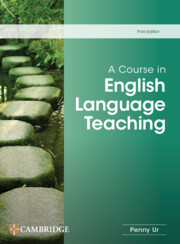Book contents
- Frontmatter
- Contents
- Acknowledgements
- Introduction
- 1 Teaching English today
- 2 The lesson
- 3 Classroom interaction
- 4 Tasks
- 5 Texts
- 6 Teaching vocabulary
- 7 Teaching grammar
- 8 Teaching listening
- 9 Teaching speaking
- 10 Teaching reading
- 11 Teaching writing
- 12 Feedback and error correction
- 13 Assessment and testing
- 14 The syllabus
- 15 Teaching/learning materials
- 16 Teaching content
- 17 Classroom discipline
- 18 Digital technology and online teaching
- 19 Learner differences 1: age
- 20 Learner differences 2: diversity and inclusion
- 21 Teacher development
- Glossary
- References
- Index
- Frontmatter
- Contents
- Acknowledgements
- Introduction
- 1 Teaching English today
- 2 The lesson
- 3 Classroom interaction
- 4 Tasks
- 5 Texts
- 6 Teaching vocabulary
- 7 Teaching grammar
- 8 Teaching listening
- 9 Teaching speaking
- 10 Teaching reading
- 11 Teaching writing
- 12 Feedback and error correction
- 13 Assessment and testing
- 14 The syllabus
- 15 Teaching/learning materials
- 16 Teaching content
- 17 Classroom discipline
- 18 Digital technology and online teaching
- 19 Learner differences 1: age
- 20 Learner differences 2: diversity and inclusion
- 21 Teacher development
- Glossary
- References
- Index
Summary
What is vocabulary?
Vocabulary can be defined, roughly, as the words in the language. However, it may include items that are more than a single word: for example, post office and mother-in-law. There are also longer multi-word expressions such as call it a day, in any case, which express a single concept and are stored in the memory as a whole chunk. A useful convention is to cover all such cases by talking about vocabulary items rather than words.
The term vocabulary is also sometimes taken to include grammatical items: pronouns such as she, someone, or determiners such as the, that, any. These are contrasted with lexical items (nouns, verbs, adjectives, adverbs). Grammatical items do not have much meaning on their own, but are used to show the relationships with other words within meaningful utterances. They are closed sets (it is unlikely that the language will acquire a new pronoun, or another demonstrative to add to this/that), whereas lexical items are an open set: items are constantly being added, lost or changed.
What students need to learn
The most important things the students need to know about a lexical item are its written and spoken form and its meaning, or meanings. However, there are additional aspects which also need to be learnt at some point: its grammar, collocational links, connotations, and appropriate contexts for use.
Form: pronunciation and spelling
The learner has to know what a word sounds like (its pronunciation) and what it looks like (its spelling). Many people assume that meaning is more important than form: but remember that knowing a meaning is pretty useless without knowing the form it is attached to. In most cases, the learners will encounter a form before they know its meaning, not vice versa – which is why it is put first here.
You may stress either pronunciation or spelling when teaching a particular item: ultimately, students will need to know both. Most English words are pronounced and spelt according to a set of reliable rules (see 11 Teaching writing, Section 5), but where they are not, you will need to teach the irregular form.
- Type
- Chapter
- Information
- A Course in English Language Teaching , pp. 71 - 84Publisher: Cambridge University PressPrint publication year: 2024



